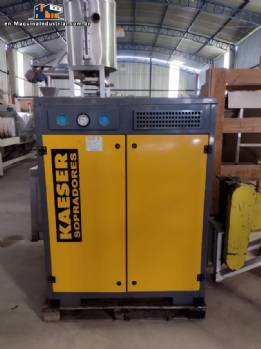Air blowers are devices designed to move air or other gases by providing a large volume air stream. They play a crucial role in various industrial and environmental applications. Let's explore what they are for, how they work and the types of air blowers:
What are worth for:
Aeration in Wastewater Treatment: Air blowers are often used in biological aeration systems to promote the growth of microorganisms that aid in the decomposition of organic materials in wastewater.
Pneumatic Transport: Blowers are used to transport bulk materials in industrial processes, such as in the food, pharmaceutical and mining industries.
Industrial Processes: They can be used in various industrial processes that require a constant delivery of air in a large volume, such as drying, cooling and ventilation.
How they work:
Positive Displacement: Most air blowers operate on the principle of positive displacement. They use rotors, lobes or screws to displace air.
Intake and Compression: Ambient air is drawn into the blower and is then compressed and moved forward. The compression process increases pressure, but not as significantly as in air compressors.
Discharge: Compressed air is discharged by the blower, providing a large volume air stream.
Types of Air Blowers:
Roots Blowers: These blowers use rotating lobes to compress and displace air. They are known for their efficiency in pneumatic conveying and aeration applications.
Rotary Screw Blowers: Use rotating screws to compress air. They are known for their energy efficiency and are common in industrial applications.
Centrifugal Blowers: They differ from positive displacement blowers as they compress the air using a high-speed centrifugal wheel. They are often
used in ventilation and air conditioning systems.
Side Channel Blowers: Also known as regeneration blowers, these blowers use the side channel principle to compress air. They are used in vacuum and pressure applications.
Vane Blowers: Use rotating vanes to compress and displace air. They are often used in vacuum and pneumatic conveying systems.
Important Features:
Efficiency: Air blowers can vary in efficiency, and the choice of type will depend on the specific needs of the application.
Speed Control: Many blowers allow speed control to adjust air delivery according to process demands.
Maintenance: Ease of maintenance is an important consideration when choosing a blower as it affects operating costs over time.
In summary, air blowers play an essential role in various industrial applications, providing high-volume compressed air for processes that require aeration, pneumatic conveying, and other operations. The choice of blower type will depend on the specific characteristics of the application and process requirements.
Air compressors and air blowers are distinct devices with specific functions and applications. Here are the main differences between them:
Main Function:
Air Compressor: The main purpose of an air compressor is to increase air pressure by providing a high-pressure stream of air. They are used in various applications, such as pneumatic tools, compressed air systems for industrial operations, spray painting, among others.
Air Blower: The air blower, on the other hand, is designed to deliver a stream of air in large volume but at a lower pressure compared to air compressors. They are often used in aeration systems, pneumatic conveying and industrial processes that require a constant delivery of large quantities of air.
Operation principle:
Air Compressor: Compresses the air, increasing its pressure. Air compressors can operate using pistons, rotating screws, vanes, among others.
Air Blower: Displaces air, providing an increase in air volume without significantly increasing pressure. Air blowers often use rotors, lobes, or screws to move air.
Pressure and Volume:
Air Compressor: They supply air at a higher pressure, making them ideal for applications that require high pressure, such as pneumatic tools.
Air Blower: They provide a large volume of air at moderate pressure, being suitable for situations where the quantity of air is more crucial than the pressure, such as in aeration systems.
Typical Applications:
Air Compressor: Widely used in mechanical workshops, manufacturing industries, civil construction, automotive painting, among others.
Air Blower: Common in wastewater treatment plants for biological aeration, pneumatic conveying systems in food and pharmaceutical industries, and industrial processes that require a large amount of air.
Energy Efficiency:
Air Compressor: Generally, air compressors are most energy efficient when the required air pressure is high.
Air Blower: They are efficient in situations where a large volume of air at a more moderate pressure is required.
Speed control:
Air Compressor: Many compressors offer the ability to control operating speed to adjust air delivery as needed.
Air Blower: May also have speed control features to optimize air delivery, but the emphasis is generally on constant volume delivery.
In summary, the main difference between air compressors and air blowers is the pressure and volume of air supplied. Compressors are designed to deliver high pressure, while blowers are optimized to deliver large volumes of air at a more moderate pressure. The choice between the two will depend on the specific needs of the application. |




